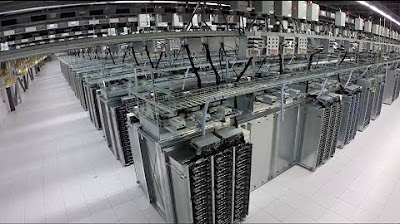The first campus built by Google | Bay View and Charleston East
Summary
TLDRThe video script discusses the innovative design and construction of Google's Charleston East and Bay View campuses, emphasizing a people-first approach. It focuses on sustainability, with features like the largest geothermal pile system in North America, rainwater capture, and a commitment to regenerative design. The building is designed to adapt to future work styles, with a mix of collaborative and quiet spaces, and integrates with nature, aiming to be a living, working laboratory that connects with people's emotions.
Takeaways
- 🏢 The future of office buildings is uncertain, with evolving concepts of work and space.
- 🌿 Charleston East and Bay View are pioneering projects that rethink the traditional office building design.
- 🤔 The unique shape of the buildings challenges preconceived notions of workspaces, promoting new ways of working.
- 💡 A people-first approach is central to the design, focusing on health, comfort, and community.
- 🌞 Natural light, thermal, visual, and acoustic comfort are prioritized for every occupant.
- 🍽️ The ground floor is designed as a communal market with meeting rooms and cafes for interaction and collaboration.
- 🔍 Physical and virtual collaboration spaces are integrated to adapt to the new hybrid work model.
- 🌱 Sustainability is a core value, with the project being the largest to pursue the Living Building Challenge.
- 💧 Water conservation and geothermal systems are utilized for a regenerative and eco-friendly design.
- 👥 A diverse group of partners and experts collaborate to innovate and push the boundaries of construction.
- 🔧 The construction process involves full-scale mockups before finalizing the design to ensure innovation.
- 🌟 The building is designed to be a living, evolving entity, adaptable to change and responsive to its occupants' needs.
Q & A
What is the main theme of the discussion about the future of work?
-The main theme is the uncertainty of how work will evolve in the coming years and the opportunity to rethink the concept of office buildings and the industry.
What is unique about the Charleston East and Bay View campuses?
-These campuses represent the first time the company led the concept and construction of its own major campuses, allowing for a rethinking of what an office building is.
How does the new office building challenge traditional preconceptions of workspaces?
-The building's unique shape leads people to question what it is, thus eliminating preconceptions of how to work based on historical office designs.
What aspects of the building design prioritize people?
-The design prioritizes people by using healthy materials, ensuring natural light, and providing thermal, visual, and acoustic comfort.
What is the purpose of the bottom level of the building?
-The bottom level serves as a market with meeting rooms, cafes, and community spaces for collaboration.
How does the building support both physical and virtual collaboration?
-The building is designed to facilitate physical collaboration in team spaces while also enhancing virtual collaboration.
What is the significance of the building's design in terms of sustainability?
-The building's design is people-first, leading to sustainability, and it's the largest project to pursue the Living Building Challenge.
How does the building contribute to the natural landscape?
-The building is designed to integrate into the natural landscape, capturing rainwater and contributing positively to the environment.
What is the largest geothermal pile system in North America and its purpose?
-The largest geothermal pile system in North America is used in the building to eliminate natural gas for heating, making the building all-electric.
How is the building designed to be regenerative?
-The building is designed to be regenerative with a commitment at the highest level, including breaking down the separation between building and power generation.
What is unique about the collaboration during the construction of the building?
-The collaboration was unique due to the diverse group of partners and experts who were willing to try innovative and unconventional approaches.
How does the building incorporate photovoltaic panels differently?
-The photovoltaic panels are not hidden but are integrated into the building's design as a beautiful material, turning every photon into daylight or power.
What is the philosophy behind the building's longevity?
-Buildings last because people care about them and are willing to continue changing them, making the building a living, working laboratory.
Outlines

このセクションは有料ユーザー限定です。 アクセスするには、アップグレードをお願いします。
今すぐアップグレードMindmap

このセクションは有料ユーザー限定です。 アクセスするには、アップグレードをお願いします。
今すぐアップグレードKeywords

このセクションは有料ユーザー限定です。 アクセスするには、アップグレードをお願いします。
今すぐアップグレードHighlights

このセクションは有料ユーザー限定です。 アクセスするには、アップグレードをお願いします。
今すぐアップグレードTranscripts

このセクションは有料ユーザー限定です。 アクセスするには、アップグレードをお願いします。
今すぐアップグレード5.0 / 5 (0 votes)






